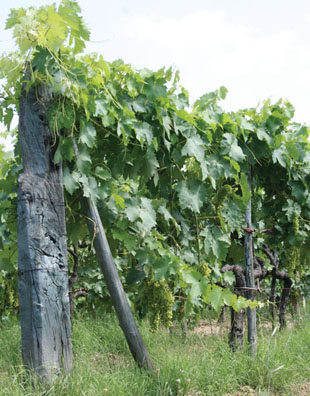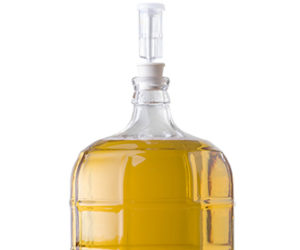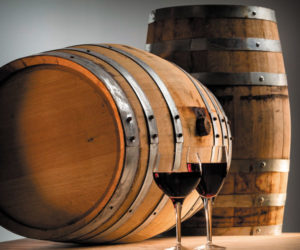Q
Is there any wine grape that can be successfully grown in an area with a heat summation of 1,200? I am near the Pacific Coast and summers are not very warm, typical 70s °F (low 20s °C), sometimes in the 80s °F (high 20s °C), but always cool at night. Some people say that Gewürztraminer or Pinot Noir may be able to grow here. Do you think they can grow under those conditions?
Tim Doherty
Blue Lake, California
A
Interestingly, even though your heat summation units are low, you are close to the Pacific Coast and so therefore I am guessing your winters are mild. Vitis vinifera grapevines grow at a minimum of 50 °F (10 °C) and winter kill at around 0 °F (-18 °C) so during the growing season, during the day, your 70s and 80s °F (20s °C) should do quite nicely.
The “Winkler Scale” or “UC Davis Heat Summation Scale,” which measures what are dubbed “degree days,” is only a rough guide to which varietals will thrive in which areas and is solely based on temperature. Basically, it looks at the temperature during the growing season, April 1 to October 31, which roughly brackets bud break to harvest in most areas of the northern hemisphere. The number of “degree days” is equal to the number of degrees Fahrenheit over 50 °F, based on average daily temperature, summed up for all the days in that period. For instance, if the average temperature is 76 °F on August 1, then the degree days for August 1 is 26. UC-Davis provides ranges of degree days that are divided into “regions” with accompanying recommended grape varietals:
Region I: Below 2,500 degree days; Chardonnay, Pinot Noir, Gewürztraminer, Riesling
Region II: 2,500-3,000 degree days; Cabernet Sauvignon, Merlot, Sauvignon Blanc
Region III: 3,000-3,500 degree days; Zinfandel, Barbera, Gamay
Region IV: 3,500-4,000 degree days; Malvasia, Thompson Seedless
Region V: Over 4,000 degree days; Thompson Seedless, other table grapes
As you can see, your 1,200 degree days is Region I or below (is that a “Region 0”?) and so Chardonnay, Pinot Noir, Gewürztraminer, and Riesling are the European grape varietals (Vitis vinifera) that you would probably have the most luck with.
As I said above, however, this scale only takes temperature into account and certainly not slope, aspect, microclimate, weather, precipitation, pest species in an area, trellising or soil composition. As you can see there are a myriad of things that can influence the success (or not) of a particular grapevine species. For example, I’m from a little surf town south of Santa Barbara called Carpinteria. If you look at its heat summation units, I should be able to do well with Region I fruit — like you, summer days typically hang out in the high 70s or low 80s °F (25–28 °C). However, Pierce’s Disease, brought on by the glassy wing sharpshooter insect, is a major deterrent to successful vineyards in the area. That and the fact that it doesn’t get very cold at night really means that Carpinteria does best with what it’s most famous for: Citrus, avocados, and flowers.
I would talk to your local university extension, county extension or farm bureau folks. Likewise, take a cue from what other farmers in your area have planted and see what you think you could do. If you need to maximize the heat that you do have, try planting vines on a south-facing slope, or a spot that is sheltered from big ocean breezes that may stress vines too much. If all else fails, try some Vitis vinifera hybrids like Marechal Foch or Leon Millot that are tailor-made for cooler areas.
Q
I have a new 26-gallon (100-L) Hungarian oak barrel full of Merlot wine. When I went to top it off this month, I found a thick white film on top of the wine. It was so thick that it stuck to the wine thief when I took a sample to test for pH. The wine still smells and tastes OK. I have been making wine for 10 years and I have never seen this before. I added some SO2, over-filled the barrel until I didn’t see any more of the “white stuff” come out and put the bung back in. Is this something I should really be worried about? And is there anything else I should be doing?
Pete Russo
Newberg, Oregon
A
It sounds like you are doing the right thing. This is probably an aerophilic “flor” type yeast that is eating alcohol, and in the presence of air (if it was slightly untopped) decided to have a little fun in the headspace. If you don’t feel the taste or aroma are really damaged or changed, completely topping, plus adding a little bit of extra sulfur dioxide should do it. I would keep an eye on the headspace in the barrel, however. Do you possibly have a leak in the barrel? Is the bunghole forming a tight seal with the bung? Sometimes bungs can harden with time and, due to lack of elasticity, form an imperfect seal.
Did you check the pH? If it’s much over 3.60 your SO2 will have a hard time being effective even if you did add a little bit more. If you suspect you might have a higher pH I would perhaps add 0.5 g/L tartaric acid and stir in gently without oxygenating. Definitely keep the sulfur dioxide at least 15 ppm higher than you normally do, keep that headspace completely topped and keep an eye on it. You may only see this problem once. Then, when you do finally empty the barrel, be sure to clean it extremely well with lots of hot water and a caustic that produces hydrogen peroxide, like “Peroxycarb.”
Q
This fall I bought Zinfandel, Cabernet Sauvignon, and Merlot from Washington State. The Zinfandel is doing fine. The mix of Cabernet Sauvignon/Merlot was crushed, fermented for about 10 days and then pressed. After that I moved the juice to three demi-johns (14 gallon/54 L) to age and after a week in the demi-johns the juice started to ferment again until the beginning of January. In February I racked the wine and it had a very mild fizzy taste and when the wine is swirled it releases an odd odor and it does not have a clear color like the Zinfandel. Everything was cleaned and sterilized. This is the first time I have had this problem. Members of my wine club say it may be going to vinegar, which is not what I want. Is there any way to stop it from turning to vinegar?
Aldo Marchioro
Coquitlam, British Columbia
A
It’s hard to tell exactly what may be the issue because wines that just finish fermenting and are so young often have “funny” smells and do indeed not smell like the finished wine that you are used to buying off a shelf. It’s hard to know if you are experiencing a bacteria or yeast-caused issue. If you didn’t complete primary fermentation it’s possible that you still may have active yeast that are possibly finishing a very long, protracted alcoholic fermentation. This would explain the “funny” odor and a release of carbon dioxide.
Your wine may also be going through malolactic fermentation (MLF), which is brokered by lactic acid bacteria. I’ve seen the volatile acidity creep on wines undergoing MLF, especially if there happens to be a bit of residual sugar sitting in the wine.
If, however, you’ve sent the wine out for analysis and your residual sugar is less than 0.20 g/100 mL (dry), your wine is ML complete, and your volatile acidity is climbing, I would suspect bacteria.
Acetic acid, or vinegar, in wine is most commonly caused by bacteria called “Acetobacter” eating alcohol and turning it into vinegar. Acetic acid can also be caused by yeast during primary fermentation, though this is less common. Air can exacerbate the production of acetic acid because the acetic acid bacteria are “aerophilic,” i.e. they need air to survive. Unfortunately, acetic acid bacteria are ubiquitous in the environment. You probably are breathing some in right now. When conditions are right, they find a food source, are exposed to air and are warm and “happy”, vinegar is an inevitable result. Here are my best tips for minimizing the production of acetic acid over the lifetime of your wine:
• Practice good cleaning and sanitation methods in winemaking
• Always inoculate with known organisms
• Aim for complete primary and secondary fermentations
• Keep dry (finished fermentation) wine away from oxygen
• Keep containers “topped up” to exclude air contact
• Store wine with free sulfur dioxide levels at least 25 ppm, higher if low alcohol, high pH or with residual sugar.
Q
Why do home winemaking kits come with glass to ferment in, and larger winemakers use barrels (wood)?
Nichole Kemp
Moorpark, California
A
Home winemakers tend to ferment in glass carboys (big 5-gallon/19-L jars, essentially) because they are usually better-sized and more convenient to a home hobbyist than larger vessels like a 59-gallon (223-L) barrel.
Additionally, carboys are inert, easy to heat or cool (heating pad or cold packs), pretty easy to move around and are especially easy to clean. In fact, they’re clear so you can see if you’ve done a good job. In contrast, a barrel is not easy to clean, is hard to move around and store, is extremely heavy and also is extremely expensive. A good, sound used barrel can cost $200 whereas a brand new French oak barrel will cost $1,000 or more. By comparison, a 5-gallon (19-L) or 6-gallon (23-L) glass carboy will run you around $30 to $50.
Granted, when home winemakers start to make more volume, and especially if they want to emulate styles where oak aging is important, they often do graduate to using barrels. Sometimes you can get 35-gallon (132-L) “half barrels” from barrel suppliers, which will enable the home winemaker to grow a little without committing to the full half-ton purchase of grapes (again, could be another $1,000) that a 59-gallon (223-L) barrel necessitates.
Some home winemakers compromise by fermenting in stainless steel kegs of 5–15 gallons (19–57 L) in volume. Stainless steel can be great, and I’ve often used it, especially for white or pink wines, but since they are opaque it’s sometimes hard to tell visually if you’ve done a good job cleaning and sanitizing. However, homebrewing supply stores do tend to keep a good stock of both kegs and carboys and all the fittings, so you should be able to find a solution that works for you in your home winemaking endeavor.







